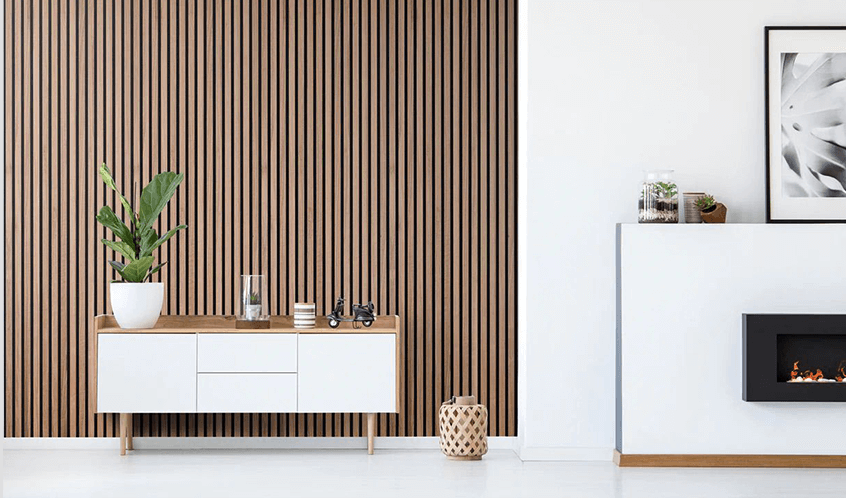Wood wall paneling can bring warmth, character, and elegance to any interior space, making it a popular choice among homeowners and designers alike. However, despite its aesthetic appeal and potential to elevate room ambiance, wood wall paneling is not without its disadvantages. This blog will explore the key drawbacks of wood wall paneling to help readers make an informed decision before incorporating it into their homes.
1. Susceptibility to Moisture and Humidity
Wood is a natural material that responds to its environment, making it highly susceptible to moisture and humidity. This is a crucial consideration for homeowners, particularly those living in humid climates.
- Warping and Swelling: When exposed to high moisture levels, wood panels can warp or swell. This can lead to gaps between panels or an uneven surface, compromising the visual appeal of the wall.
- Mold and Mildew: Moist environments can encourage mold and mildew growth, especially if the wood is not properly sealed or treated. This can lead to unsightly stains and potential health risks.
Tip: To minimize these issues, ensure that wood paneling is installed in areas with good ventilation and minimal moisture exposure. Use specially treated or sealed panels in moisture-prone spaces.
2. Cost Considerations
One of the most significant drawbacks of wood wall paneling is its cost. Quality wood panels can be expensive compared to other wall finishing options such as paint or wallpaper.
- High Initial Investment: The upfront cost of purchasing and installing wood wall paneling can be substantial, especially for high-end or exotic wood varieties.
- Ongoing Maintenance Costs: Wood paneling requires regular maintenance, such as cleaning and refinishing, to maintain its appearance and prevent damage over time.
Cost Comparison
| Wall Finish Type | Initial Cost ($/sq. ft) | Maintenance Cost (Annually) |
|---|---|---|
| Wood Paneling | $5 – $30 | $1 – $5 |
| Paint | $1 – $3 | $0.50 – $1 |
| Wallpaper | $2 – $5 | $0.50 – $2 |
3. Vulnerability to Damage
Wood wall paneling, while durable to an extent, can still be prone to damage from various sources.
- Scratches and Dents: Wood panels can be easily scratched or dented by furniture, pets, or daily household activities. This can be a significant drawback for families with young children or high-traffic areas.
- Pest Issues: Certain types of wood are susceptible to pest infestations, such as termites, which can compromise the structural integrity of the panels.
Tip: To mitigate damage, select durable woods such as oak or teak and ensure they are treated with protective finishes.
4. Maintenance Requirements
Maintaining wood wall paneling can be time-consuming and costly.
- Regular Cleaning: Dust and dirt can accumulate on the surface of the panels, requiring regular cleaning to maintain a polished look.
- Refinishing Needs: Over time, wood panels can lose their luster and may need to be refinished or re-stained to keep them looking fresh. This process can be labor-intensive and expensive.
- Re-sealing: To protect against moisture and damage, wood panels may need to be re-sealed periodically.
Maintenance Checklist
- Dust weekly to prevent buildup.
- Inspect for signs of warping or damage monthly.
- Re-seal every 1-2 years, depending on environmental conditions.
5. Limited Versatility
While wood paneling can create a classic or rustic look, its design versatility is limited compared to other wall finishes.
- Style Constraints: Wood wall paneling tends to fit better with specific interior styles, such as traditional, rustic, or farmhouse. For homeowners seeking a modern or minimalist look, wood paneling may not align with their vision.
- Color Options: Although wood can be stained or painted, it generally offers fewer color choices compared to paint or wallpaper.
Tip: If versatility is important, consider combining wood paneling with other materials or opting for panels that can be painted to fit different aesthetics.
6. Environmental Impact
The environmental impact of using wood wall paneling is another important consideration for eco-conscious homeowners.
- Deforestation Concerns: The production of wood panels can contribute to deforestation and habitat loss if not sourced sustainably.
- Carbon Footprint: Manufacturing, transporting, and installing wood panels all contribute to a higher carbon footprint compared to some alternative wall finishes.
Tip: Choose wood paneling from certified sustainable sources, such as those with FSC (Forest Stewardship Council) certification, to reduce environmental impact.
7. Installation Challenges
Installing wood wall paneling can be more complicated and labor-intensive than other wall treatments.
- Professional Installation: For the best results, wood paneling often requires professional installation, adding to the overall cost and complexity.
- Time-Consuming: Proper installation involves measuring, cutting, and securing each panel, which can take considerably more time than applying paint or wallpaper.
Installation Steps
- Measure the wall and cut panels to size.
- Apply adhesive or use nails to secure the panels.
- Finish with stain or sealant for protection.
FAQs
1. Is wood wall paneling suitable for bathrooms?
While wood paneling can be used in bathrooms, it must be specially treated to resist moisture and prevent warping or mold growth.
2. How do I maintain wood wall paneling?
Dust the panels regularly, inspect for damage, and re-seal them every 1-2 years to maintain their appearance and longevity.
3. Can I paint over wood paneling?
Yes, wood paneling can be painted, but it requires proper preparation, such as sanding and priming, to ensure the paint adheres well.
4. What types of wood are best for paneling?
Durable woods like oak, maple, and cedar are popular for wall paneling due to their strength and resistance to damage.
5. Is wood paneling environmentally friendly?
It can be, if sourced from sustainable providers. Look for wood with FSC certification to ensure it meets eco-friendly standards.
By understanding the drawbacks of wood wall paneling, homeowners can weigh the pros and cons to make the best decision for their spaces. While it offers beauty and charm, the associated maintenance, cost, and potential issues should be considered to ensure it’s the right fit for your home.








